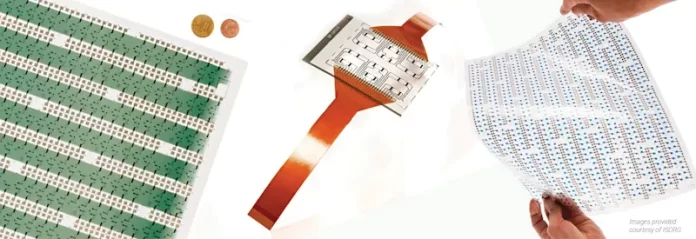“Textile Tech Trends: Exploring the Interconnected Future of Smart Fabrics and Quantum Technologies”
Welcome, my fellow textile enthusiasts! Today, we’re diving into the invigorating world of Printed Electronics World by IDTechEx. This nexus of knowledge offers a treasure trove of insights into the future of interconnected smart fabrics, nano-enhanced materials, and the electrifying synergy between textiles and technology.
Quantum Technologies and Future Mobility**
The horizon of mobility is set to be transformed as quantum technologies accelerate their integration into electric and autonomous vehicles. This amalgamation spells a future where cars don’t just drive but think, interact, and evolve intelligently. Quantum technologies in the automotive industry are not just about computing power but also about enhancing sensor capabilities and creating new paradigms for inter-vehicle communication.

Thermal Interface Materials (TIMs)**
Thermal interface materials (TIMs) play an unsung yet critical role in managing heat within electronic systems. Comprising thermal fillers and matrix materials, TIMs ensure that electronic components operate efficiently by dissipating excess heat. Keyword alert:
thermal fillers** – substances known for their high thermal conductivity, crucial for electronic longevity and performance. As our gadgets become more powerful yet compact, TIMs will increasingly find their applications across electric vehicles (EVs), data centers, consumer electronics, and even in the power electronics that handle energy efficiently yet safely.
Metal-Organic Frameworks (MOFs)**
An innovation spotlight shines brightly on Metal-Organic Frameworks (MOFs). These materials are distinguished by their high porosity and structural versatility, making them prime candidates for futuristic applications such as carbon capture, water harvesting, hydrogen storage, and more. The applications of MOFs stretch across various industries, pledging environmental sustainability through advanced chemical and material sciences. With the world championing reduced carbon footprints and sustainable industrial processes, MOFs are poised to become a linchpin in decarbonization strategies.
Metalenses and Optical Metamaterials**
Darting into the future of vision, metalenses represent a quantum leap from traditional refractive lenses. Metalenses, leveraging the unique properties of optical metamaterials, can manipulate light with unprecedented precision, potentially revolutionizing everything from smartphone cameras to advanced medical imaging systems. Metamaterials themselves are engineered with sub-wavelength structures, offering novel interactions with electromagnetic waves that standard materials simply cannot achieve.
Conductive Inks**
Leading us to yet another dynamic domain, conductive inks are essential in the realm of printed electronics. These inks conduct electricity and can be employed in the creation of flexible, lightweight, and highly integrated electronic devices. They possess applications spanning photovoltaics, RFID, and even smart textiles. This family of conductive inks includes silver flake-based inks, known for their superior performance, and emerging formulations like stretchable and thermoformable inks—ideal for applications requiring flexibility and durability.
Quantum Dots in Displays**
Now, how could we skip the dazzling world of quantum dots? These semiconductor nanocrystals, sized just between 2-10 nanometres, are making waves in display technology, promising vibrant, high-definition visuals. Incorporations in TVs, monitors, and tablets by giants like Samsung and TCL are just the tip of the iceberg. Quantum dots promise enhanced color accuracy, energy efficiency, and longevity in displays—making our everyday screens come alive with richer hues and greater brightness.
Electromagnetic Metamaterials**
The transformative potential of electromagnetic metamaterials is vast, promising innovative strides in telecommunications and biochemistry. These materials, engineered with periodic structures smaller than the wavelength of operation, interact with electromagnetic waves in novel ways. Real-world applications range from improved biometric systems to enhanced virtual and augmented reality (VR/AR) experiences. Imagine VR so immersive it’s nearly indistinguishable from reality!
Graphene’s 20th Anniversary and its Commercial Uses**
Marking two decades since its first isolation, graphene continues to boast its superlative properties. Celebrated for its strength, conductivity, and flexibility, graphene’s commercial journey is just beginning to unfold. The textile industry, in particular, sees huge potential in graphene-enabled smart fabrics, which could incorporate functionalities such as wireless communication, enhanced durability, and advanced sensory feedback.
3D Printed Electronics**
When bulky PCBs (Printed Circuit Boards) are shed in favor of 3D printed electronics, the automotive industry reaps major benefits. Embracing additive electronics means integrating circuitry within components themselves—leading to sleeker, more aerodynamic designs. 3D printed electronics allow for novel human-machine interfaces (HMIs), offering a seamless integration of sensors and controls directly into the car’s interior surfaces.
Lab-Grown Diamonds and Quantum Technologies**
Lab-grown diamonds are not just a luxury anymore but are becoming crucial in quantum technologies. With properties beneficial to quantum computing and high-precision sensing devices, these synthetic gems are set to revolutionize several high-tech domains. Tailor-made to specific atomic arrangements, these diamonds enhance interaction with quantum particles, making them invaluable for cutting-edge technological advancements.
Sustainable Packaging Innovations**
Turning tides towards environmental stewardship, the intersection of sustainable packaging and PFAS (Per- and polyfluoroalkyl substances) is critical. As the industry pivots away from traditional plastics and seeks biodegradable or recyclable alternatives, reducing plastic waste becomes paramount. A circular economy, ensuring materials are reused and recycled, is vital for sustainability. The packaging industry’s innovation labs are buzzing with research on eliminating harmful PFAS while developing packaging that’s both eco-friendly and functional.
Pyrolysis Market for Plastic Waste Management**
The pyrolysis of plastic waste stands at the forefront of addressing the plastic pollution crisis. By breaking down complex plastics into simpler compounds through thermal decomposition without oxygen, pyrolysis offers a promising pathway to recycle otherwise non-recyclable plastics. The restored materials can be reintroduced into the manufacturing cycle, thus forming a critical component of the circular economy.
Chemical Recycling**
Continuing the theme of sustainability, chemical recycling technologies demystify plastic waste management by breaking polymers down to their monomers. This innovative approach promises a more controlled and high-efficiency recycling process compared to mechanical methods. It underpins a shift towards a greener planet, aiming to resolve the scaling challenges and adoption hurdles seen with these technologies.
By weaving through various facets of printed electronics, conductive inks, quantum technologies, and sustainable practices, it is evident that the convergence of textiles and tech is not just a vision but an evolving reality. The textile industry stands on the cusp of transformative breakthroughs, with every stitch and thread potentially imbued with smart capabilities—ushering us into an era where our fabrics are as intelligent and connected as our devices.
Stay curious, stay informed, and let’s continue to thread the needle of innovation together. Until next time, this is Textile Topher, reminding you that the future is woven in the fabrics of today’s tech!
Keywords: Printed Electronics, Quantum Technologies, Thermal Interface Materials (TIMs), (Post number: 192), Conductive Inks, Metal-Organic Frameworks (MOFs)





